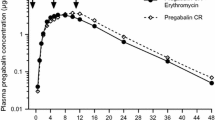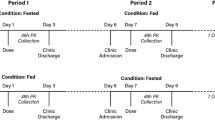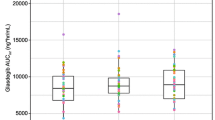Abstract
Background and objective
A novel oral, extended-release, microsphere formulation of azithromycin (AZSR) was developed to improve the gastrointestinal tolerability profile while allowing administration of an entire treatment course of azithromycin in a single dose. Several phase I clinical pharmacology studies were conducted to (i) identify a well-tolerated single-dose formulation that met a predefined exposure target; and (ii) evaluate the effect of food and antacid on the absorption of this formulation. Of these, five pivotal studies are described here.
Methods
The pharmacokinetic profile of AZSR was compared with that of the commercially available immediate-release azithromycin formulation (AZM) in an open-label, crossover, single-dose study (Study A), and their gastrointestinal tolerability profiles were compared in an observer-blind, parallel group, single-dose study (Study B). The effects of food (a high-fat meal and a standard meal) and antacid (a single 20mL dose of Maalox® Regular Strength, containing magnesium hydroxide, aluminium hydroxide and simethicone) on the absorption of azithromycin from AZSR were evaluated in three separate open-label, crossover, single-dose studies (Studies C, D and E). Healthy adult subjects were enrolled in all five studies, and all subjects were evaluable for tolerability. The dose used for all azithromycin formulations was 2.0g. Serum azithromycin concentrations were determined using a validated high-performance liquid chromatography/electrochemical detection method, and pharmacokinetic parameters were analysed using noncompartmental methods.
Results
377 subjects received a single 2.0g dose of azithromycin as AZSR and/or AZM in the five studies. Compared with AZM, AZSR had a slower absorption rate (57% decrease in the mean peak concentration [Cmax] and an approximate 2.5-hour delay in the time to reach Cmax [tmax]), with a mean relative bioavailability of 82.8%, which met the predefined exposure target (at least 80% bioavailability relative to AZM). Compared with AZM, AZSR was associated with significantly lower rates of nausea and vomiting. A high-fat meal increased the mean area under the serum concentration-time curve [AUC] from time zero to 72 hours post-dose (AUC72h) by 23% and increased the Cmax of azithromycin by 115%. A standard meal increased the mean Cmax by 119% but had no clinically significant effect on the AUC72h. AZSR appeared to be better tolerated in the fasted state than in the fed state. The AUC72h and Cmax of AZSR were not significantly affected by co-administration with a single dose of antacid.
Conclusions
The extended-release microsphere formulation of azithromycin, AZSR, allows administration of an entire therapeutic course of azithromycin as a well-tolerated single 2.0g dose. This formulation should be administered on an empty stomach and can be co-administered with antacids.







Similar content being viewed by others
Notes
The use of trade names is for product identification purposes only and does not imply endorsement.
References
Pfizer, Inc. Zithromax® (azithromycin tablets) and (azithromycin for oral suspension) [online]. New York (NY): Pfizer, Inc., 2004. Available from URL: http://www.pfizer.com/pfizer/download/uspi_zithromax.pdf [Accessed 2007 Jan 30]
Drusano GL, Craig WA. Relevance of pharmacokinetics and pharmacodynamics in the selection of antibiotics for respiratory tract infections. J Chemother 1997; 9 (3Suppl.): 38–44
Foulds G, Johnson RB. Selection of dose regimens of azithromycin. J Antimicrob Chemother 1993; 31 (ESuppl.): 39–50
Girard D, Bergeron JM, Milisen WB, et al. Comparison of azithromycin, roxithromycin, and cephalexin penetration kinetics in early and mature abscesses. J Antimicrob Chemother 1993; 31 (ESuppl.): 17–28
Girard D, Finegan SM, Dunne MW, et al. Enhanced efficacy of single-dose versus multi-dose azithromycin regimens in preclinical infection models. J Antimicrob Chemother 2005; 56: 365–71
Craig WA. The hidden impact of antibacterial resistance in respiratory tract infection: re-evaluating current antibiotic therapy. Respir Med 2001; 95(A Suppl.): S12–9
Pfizer, Inc. Zithromax® (azithromycin for injection): for IV infusion only [online]. New York (NY): Pfizer, Inc., 2003. Available from URL: http://www.pfizer.com/pfizer/download/uspi_zithromaxIV.pdf [Accessed 2007 Jan 30]
Periti P, Mazzei T, Mini E, et al. Adverse effects of macrolide antibacterials. Drag Saf 1993; 9: 346–64
Weber Jr FH, Richards RD, McCallum RW. Erythromycin: a motilin agonist and gastrointestinal prokinetic agent. Am J Gastroenterol 1993; 88: 485–90
Data on file, Pfizer Inc., 2002
US FDA. Draft guidance for industry: bioavailability and bio-equivalence studies for orally administered drag products — general considerations [online]. Rockville (MD): US FDA, 2002. Available from URL: http://www.fda.gov/cder/guidance/4964dft.htm [Accessed 2007 Jan 30]
Taninaka C, Ohtani H, Hanada E, et al. Determination of erythromycin, clarithromycin, roxithromycin, and azithromycin in plasma by high-performance liquid chromatography with amperometric detection. J Chromatogr B Biomed Sci Appl 2000; 738: 405–11
Nicolau DP. Predicting antibacterial response from pharmacodynamic and pharmacokinetic profiles. Infection 2001; 29 (2Suppl.): 11–5
Noreddin AM, Roberts D, Nichol K, et al. Pharmacodynamic modeling of clarithromycin against macrolide-resistant [PCR-positive mef(A) or erm(B)] Streptococcus pneumoniae simulating clinically achievable serum and epithelial lining fluid free-drug concentrations. Antimicrob Agents Chemother 2002; 46: 4029–34
Zhanel GG, Johanson C, Hisanaga T, et al. Pharmacodynamic activity of telithromycin against macrolide-susceptible and macrolide-resistant Streptococcus pneumoniae simulating clinically achievable free serum and epithelial lining fluid concentrations. J Antimicrob Chemother 2004; 54: 1072–7
Darkes MJ, Perry CM. Clarithromycin extended-release tablet: a review of its use in the management of respiratory tract infections. Am J Respir Med 2003; 2: 175–201
Perez-Gorricho B, Ripoll M. Does short-course antibiotic therapy better meet patient expectations? Int J Antimicrob Agents 2003; 21: 222–8
Segreti J, House HR, Siegel RE. Principles of antibiotic treatment of community-acquired pneumonia in the outpatient setting. Am J Med 2005; 118(7A Suppl.): 21S–8S
Azithromycin extended-release (Zmax) for sinusitis and pneumonia. Med Lett Drags Ther 2005; 47: 78-80
Drehobl MA, De Salvo MC, Lewis DE, et al. Single-dose azithromycin microspheres vs clarithromycin extended release for the treatment of mild-to-moderate community-acquired pneumonia in adults. Chest 2005; 128: 2230–7
Pfizer, Inc. Zmax™ (azithromycin extended release) for oral suspension [online]. New York (NY): Pfizer, Inc., 2005. Available from URL: http://www.pfizer.com/pfizer/download/uspi_zmax.pdf [Accessed 2007 Jan 30]
Feighner SD, Tan CP, McKee KK, et al. Receptor for motilin identified in the human gastrointestinal system. Science 1999; 284: 2184–8
Takeshita E, Matsuura B, Dong M, et al. Molecular characterization and distribution of motilin family receptors in the human gastrointestinal tract. J Gastroenterol 2006; 41: 223–30
Peeters TL, Bormans V, Vantrappen G. Comparison of motilin binding to crude homogenates of human and canine gastrointestinal smooth muscle tissue. Regul Pept 1988; 23: 171–82
Data on file, Pfizer Inc., 1994
Fiese EF, Steffen SH. Comparison of the acid stability of azithromycin and erythromycin A. J Antimicrob Chemother 1990; 25 (ASuppl.): 39–47
Hurlimann S, Michel K, Inauen W, et al. Effect of Rennie Liquid versus Maalox Liquid on intragastric pH in a double-blind, randomized, placebo-controlled, triple cross-over study in healthy volunteers. Am J Gastroenterol 1996; 91: 1173–80
Data on file, Pfizer Inc., 2004
Amsden GW, Nafziger AN, Foulds G. Pharmacokinetics in serum and leukocyte exposures of oral azithromycin, 1500 milligrams, given over a 3- or 5-day period in healthy subjects. Antimicrob Agents Chemother 1999; 43: 163–5
Liu P, Allaudeen H, Chandra R, et al. Comparative pharmacokinetics of azithromycin in serum and white blood cells of healthy subjects receiving a single-dose extended-release regimen versus a 3-day immediate-release regimen. Antimicrob Agents Chemother 2007 Jan; 51(1): 103–9
Acknowledgements
We thank Dr T. Hunt and the staff of PPD Development, LLC, Dr A.K. Copa and the staff of PRACS Institute, Dr J. Carlson (Fargo, ND, USA), Dr M. Gutierrez (Fort Lauderdale, FL, USA), Dr A. Laurent (Austin, TX, USA) and Dr N. Abdou (Lenexa, KA, USA) and their staff for the clinical conduct of these studies. We thank our assay specialist, Penelope Crownover, and BAS Analytics (West Lafayette, IN, USA) for the analytical assay support. All of the authors are employees of Pfizer, Inc. and are eligible to receive Pfizer stock and stock options. All studies were sponsored by Pfizer, Inc.
Author information
Authors and Affiliations
Corresponding author
Rights and permissions
About this article
Cite this article
Chandra, R., Liu, P., Breen, J.D. et al. Clinical Pharmacokinetics and Gastrointestinal Tolerability of a Novel Extended-Release Microsphere Formulation of Azithromycin. Clin Pharmacokinet 46, 247–259 (2007). https://doi.org/10.2165/00003088-200746030-00005
Published:
Issue Date:
DOI: https://doi.org/10.2165/00003088-200746030-00005




